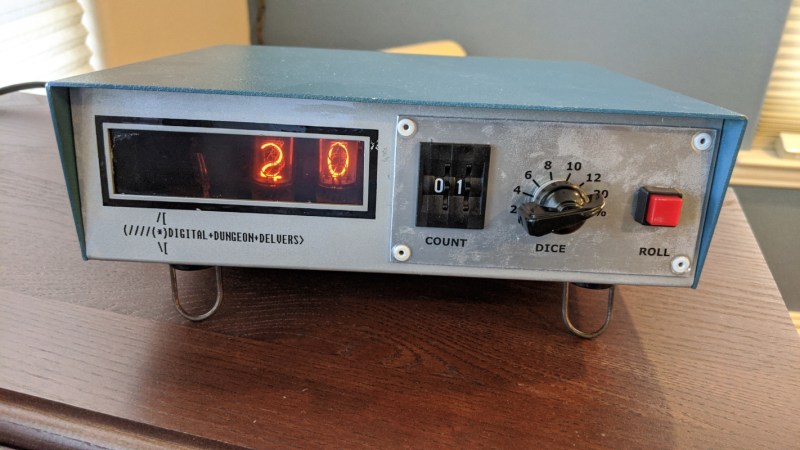For the casual Monopoly or Risk player, using plain six-sided dice is probably fine. For other games you may need dice with much more than six sides, and if you really want to go overboard you can do what [John] did and build electronic dice with a random number generator if you really need to remove the pesky practice of rolling physical dice during your games of chance.
The “digital dice” he built are based on a multimeter from 1975 which has some hardware in it that was worth preserving, including a high quality set of nixie tubes. Nixies can be a little hard to come by these days, but are interesting pieces of hardware in their own right. [John] added some modern hardware to it as well, including an AVR microcontroller that handles the (pseudo) random number generation. A hardware switch tells the microcontroller how many sides the “die” to be emulated will need, and then a button generates the result of the roll.
This is a pretty great use for an old piece of hardware which would otherwise be obsolete by now. [John] considers this a “Resto-Mod” and the finish and quality of the build almost makes it look all original. It’s certainly a conversation piece at the D&D sessions he frequents.

















Use this and you can play Shadowrun without going broke:
https://hackaday.com/2020/01/18/bask-in-the-glory-of-this-336-led-digit-display/
In Electronics lab, we had a Nixie based piece of test equipment (freq. counter?) that when a certain button was pushed it would do a rapid update of the display. (5 or 6 digits) When the instructor wasn’t around, we’d play Poker and see who would get the best “hand” with each press of that button. This “RNG” occurred when the equipment wasn’t connected to anything.
A few weeks later, one of the instructors confided with me that our games had caused the equipment to fail, and was being repaired.
Memories
1989 in Germany
8th ASOC, Kelly Barracks
Radio Maintenance
Freq Counter Bingo!
(Boy, were we bored.)
Sooo it’s got nothing left of the multimeter apart from the case and the nixies. Not really a nixie multimeter AS a dice, more a nixie multimeter scrapped INTO a dice.
Pedant. It was a shit multimeter to begin with, the Nixies and the case were the only things useful.
I’d hardly call it a shit multimeter, I used mine quite a bit for many years, alongside a Fluke 87. They never really disagreed by enough to matter for my purposes.
even then, it’s really nothing to make an article about. the guy just made a dice with a fancy case and nixies instead of leds. All in all nothing special, and certainly not worth an article.
If he actually had made it as a plug-able module that you can adapt on any multimeter that would tell you the die’s results as a voltage output easily readable by the multimeter, now THAT would have been worth writing an article about.
Apparently, he did enough to set you off….yawn.
You missed the original point of the project. It’s not about a “multimeter” that can roll dice. It’s a riff on a Dungeons and Dragons Digital Dice Device you could have ordered and assembled from a HeathKit catalog in 1978. Those never actually existed, yet here is this one with all of it’s original 40 yr old patina.
Nothing about this project is technically “special” or even difficult, but the result is very unique. It can be easily built in a day from parts you can buy off e-bay (which happens to include a Bell & Howell IMD-202-2 multimeter) and a couple other suppliers. In my opinion, that fits the definition of a “hack”.
Even if that’s all he did it’s still a neat project.